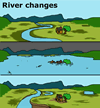Impacts on environments: Natural
Natural environmental changes affect the kinds and numbers of organisms in an area at any given time.
Short-term
Some environmental factors experience regular cyclic changes causing short-term
variations in conditions and populations.
- Tides cause changes in water availability and temperature, salt concentration,
and food.
- Day/ night variation affects temperatures, and light intensity (eclipses
occasionally disrupt this!). Changes in day length stimulate flowering
in some plants.
- Seasons alter weather and often trigger hibernation, or migration (to follow food sources), or life cycles.
Medium-term
Floods, drought and fire are natural factors impacting on environments
but which, over a longer time frame, are still part of the natural, stable
ecosystem.
|
Long-term
Some natural impacts are extreme and have very long-lasting effects.
- Volcanoes
Volcanic action is devastating to natural ecosystems, with all living things in the path of the lava buried and killed by heat and suffocation. In time, however, life will return to the area as simple life forms grow and alter the environment making it more suitable for other organisms. This is called succession. (see Ecosystems and foodwebs)
- Meteor impact
Evidence suggests that, at various times in the Earth's history, large meteors have collided with Earth creating huge dust-storms. One such event is suggested to have been the cause of the dinosaurs' extinction through low light intensity and subsequent reduced plant growth.
| Copyright owned by the State of Victoria (Department of Education and Early Childhood Development). Used with Permission. |
|
|||||||||||||||||||||||||||||||||||||||||||||||||||||||||||||||||||||||||||||||||||||



